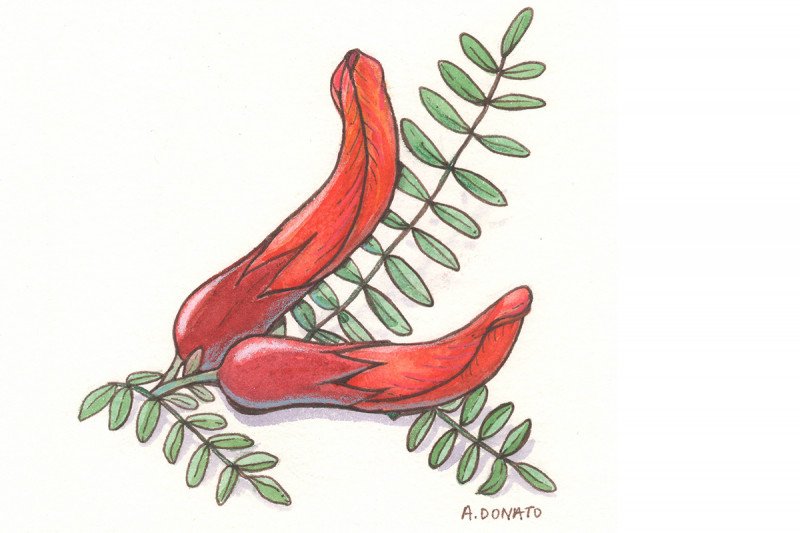
Common Names
- Sutherlandia
- Cancer bush
- Kankerbos
- Balloon-pea
For Patients & Caregivers
Tell your healthcare providers about any dietary supplements you’re taking, such as herbs, vitamins, minerals, and natural or home remedies. This will help them manage your care and keep you safe.
What is it?
Lab studies suggest Sutherlandia has anticancer properties, but this has not been shown in humans.
Sutherlandia frutescens is a shrub native to South Africa and along the coast of West Africa. It is used in traditional medicine to treat diabetes, chicken pox, external wounds, and cancer.
Lab studies suggest Sutherlandia can fight off viruses, bacteria, and fungi. It also appears to have anticancer properties. A few case reports suggest it may help decrease fatigue in cancer patients.
Sutherlandia has been proposed as an AIDS treatment in Africa. However in a trial of adults with HIV, patients taking Sutherlandia did not experience benefits, and had longer infection times. Additional studies are needed.
What are the potential uses and benefits?
- Infections
Lab studies suggest antibacterial, antiviral, and antifungal effects. However in a study of HIV patients, 2 cases of tuberculosis occurred in the Sutherlandia group, even though they were on preventive therapy for tuberculosis. - Stomach and blood ailments
There is no scientific evidence to support this claim. - Cancer
Sutherlandia showed anticancer effects in lab studies, but this has not been studied in humans. - AIDS
Lab studies suggest antiviral properties. However in a study of HIV patients, those who took Sutherlandia did not experience benefits over placebo, but infection times were longer in a few patients.
What are the side effects?
Common: Diarrhea, dry mouth, dizziness.
Rare: Drinking or swallowing high doses of Sutherlandia may cause sweating and vomiting.
What else do I need to know?
Do Not Take if:
- You are taking isoniazid: In a safety trial of adults with HIV, a possible interaction between S. frutescens and isoniazid occurred, as 2 participants developed tuberculosis despite taking isoniazid.
- You are taking antiretrovirals (eg, atazanavir): Studies in human subjects suggest Sutherlandia may reduce the bioavailability of atazanavir. Also, many antiretrovirals are metabolized by CYP3A4.
- You are taking CYP3A4 substrate drugs: Lab studies suggest Sutherlandia may interact with these drugs and increase the risk of side effects. Clinical relevance has yet to be determined.
- You are taking P-gP substrate drugs: Lab studies suggest Sutherlandia may increase the risk of side effects of these drugs. Clinical relevance has yet to be determined.
For Healthcare Professionals
Scientific Name
Clinical Summary
Sutherlandia frutescens is a shrub native to South Africa and the coast of West Africa. This plant and its related species have been used in traditional medicine to treat diabetes, chicken pox, external wounds, and cancer. Although Sutherlandia is not generally consumed as a dietary supplement in the West, some use the raw herb as an adaptogen.
Constituents in Sutherlandia have antiviral, antibacterial, antifungal and anticancer properties (2). A few case reports suggest it may help decrease fatigue in cancer patients (3), but whether it could be used as a treatment for cancer has not been studied in humans.
Due to limited access to pharmaceuticals, an effort in Africa to promote local herbs to treat AIDS has included Sutherlandia (4) (5). However in a double-blind safety trial in adults with HIV, patients randomized to S. frutescens did not have changes in viral load or CD4 T-lymphocyte count, but did have longer duration of secondary infection (1).
Adverse effects are rare but Sutherlandia may interact with CYP3A4 and P-glycoprotein substrate drugs, and particularly drugs used to treat AIDS or prevent tuberculosis (1) (7) (16) (17).
Food Sources
- Sutherlandia frutescens is generally consumed as a tea.
Purported Uses and Benefits
- Infections
- Stomach and blood ailments
- Cancer
- AIDS
Mechanism of Action
In vitro studies suggest Sutherlandia has antioxidant and anti-inflammatory effects (9). The constituent pinitol demonstrated antidiabetic effects by increasing availability of glucose for cell metabolism (2). Sutherlandia upregulated VAMP3, a gene which plays a role in vesicle transport, and also regulated 26 other genes that code for vesicle transporters, receptors, signalling molecules, transcription factors, and metabolic enzymes (14). GABA found in the dry leaves of this herb can slow down nerve cell activity (2).
An ethanolic extract of Sutherlandia inhibited growth of MCF-7 breast adenocarcinoma cells by inducing apoptosis (10) (11). Sutherlandia also downregulated metalloproteinases that control cell migration, proliferation, and apoptosis, and regulate tumor expansion, angiogenesis, and dissemination (10).
Contraindications
- Patients taking isoniazid to prevent tuberculosis should avoid taking Sutherlandia, as it may interfere with the effectiveness of that drug (1).
Adverse Reactions
Herb-Drug Interactions
- Isoniazid: In a double-blind safety trial of adults with HIV, a possible interaction between S. frutescens and isoniazid preventive therapy occurred, as 2 participants taking Sutherlandia developed tuberculosis despite taking isoniazid (1).
- Atazanavir: In human subjects, Sutherlandia significantly reduced bioavailability of this antiretroviral protease inhibitor (17).
- CYP450 substrates: In vitro, Sutherlandia inhibits CYP3A4 and can affect the intracellular concentration of drugs including antiretrovirals metabolized by these enzymes (7). But in an animal study, it induced rat CYP3A2/human equivalent CYP3A4, resulting in decreased intracellular concentrations of nevirapine, a non-nucleoside reverse transcriptase inhibitor (16). Clinical relevance has yet to be determined.
- P-gP substrates: In vitro, Sutherlandia inhibited P-Gp activity and may interfere with the metabolism of drugs including antiretrovirals (7). Clinical relevance has yet to be determined.